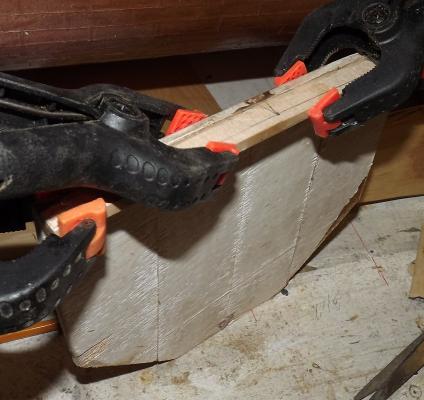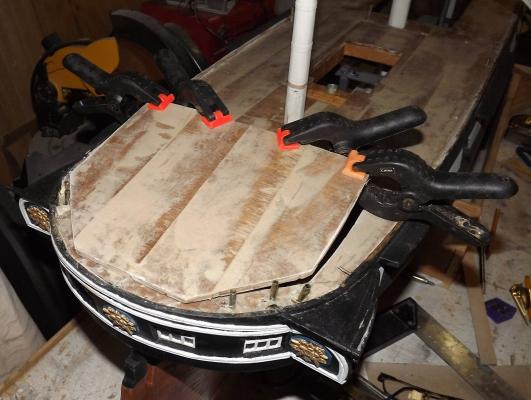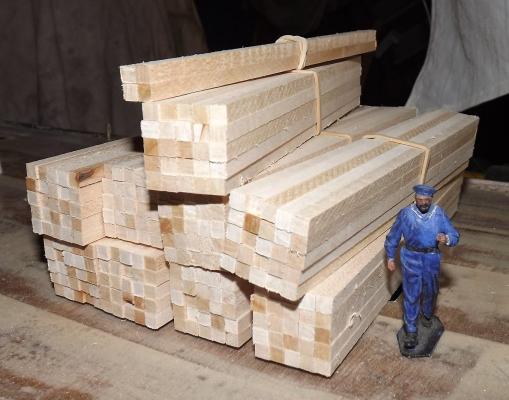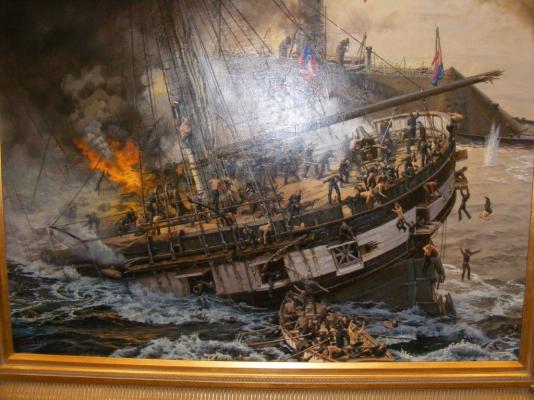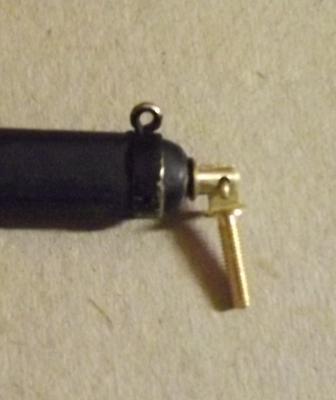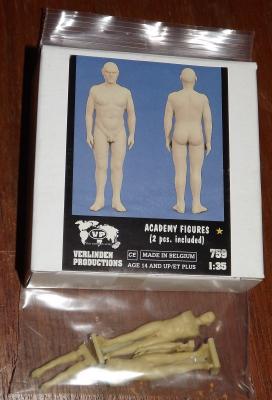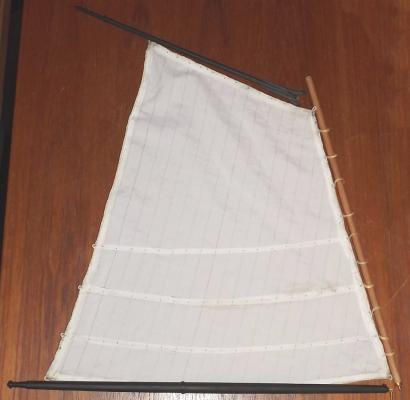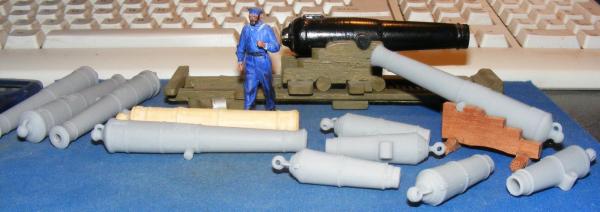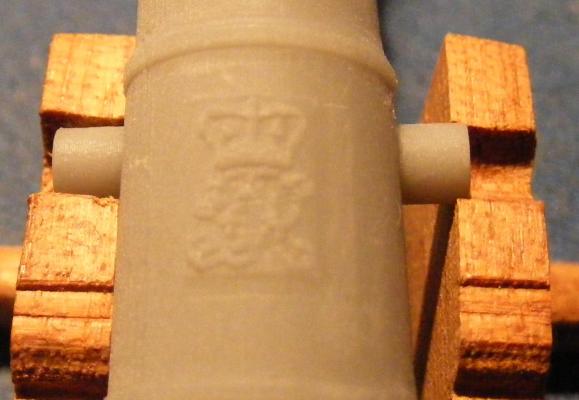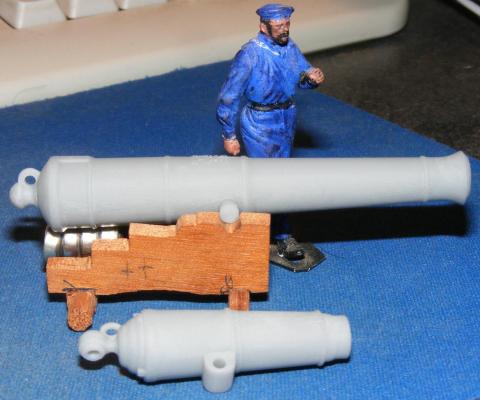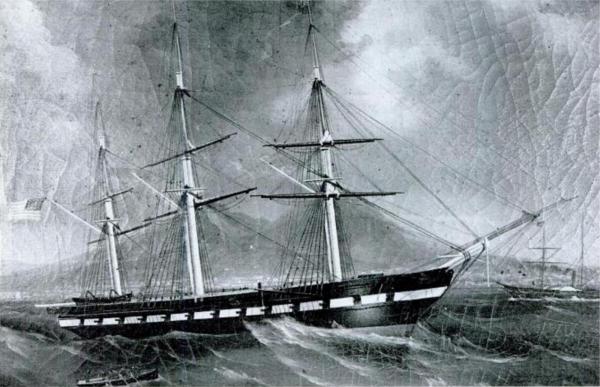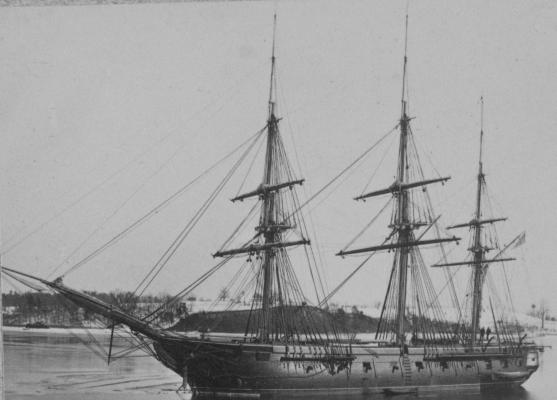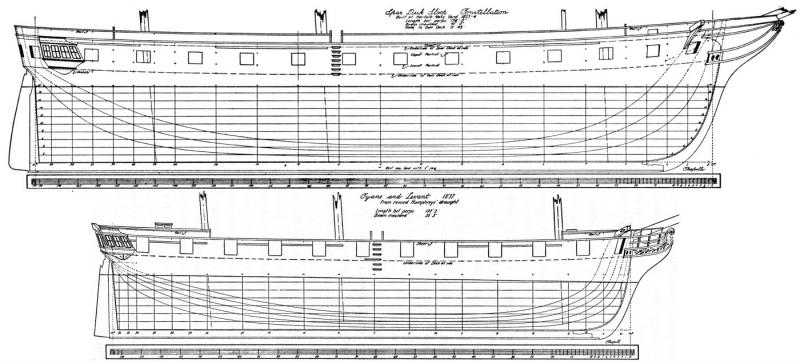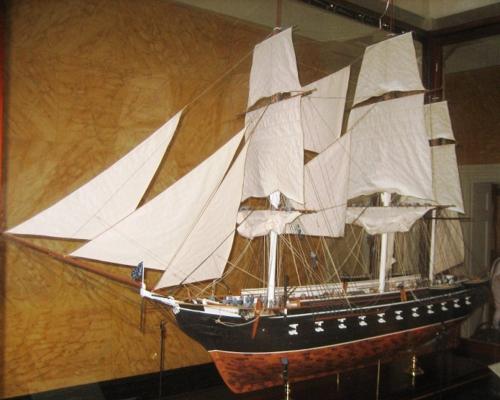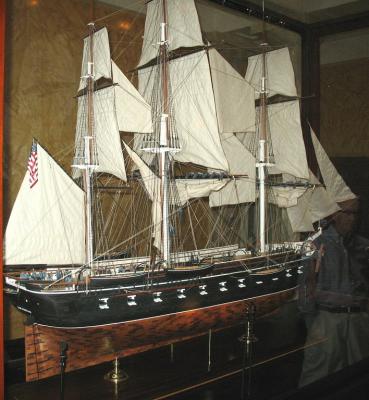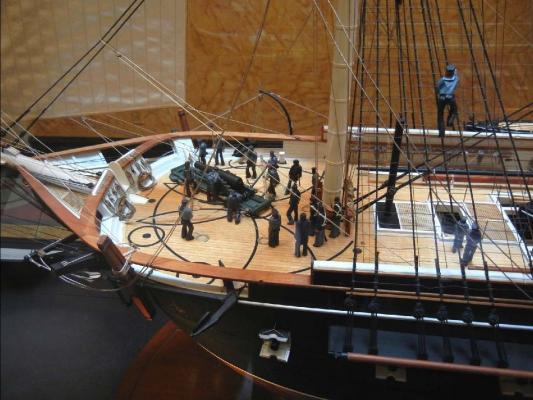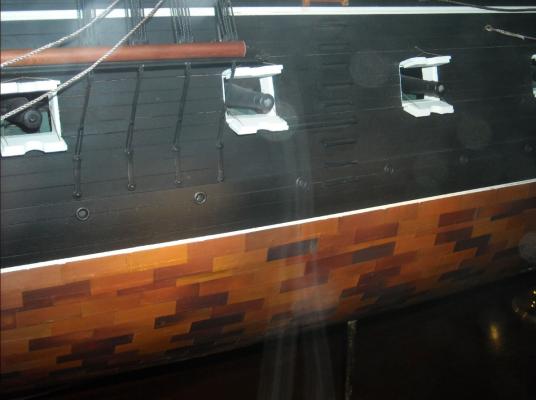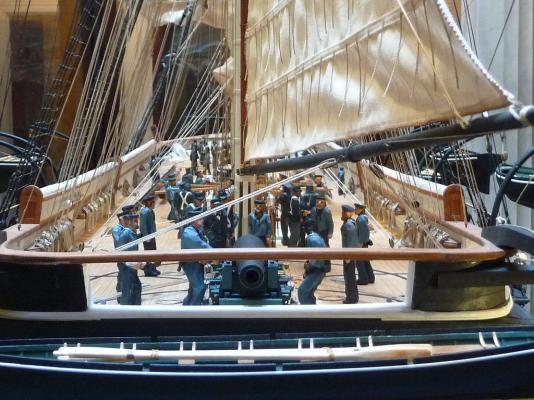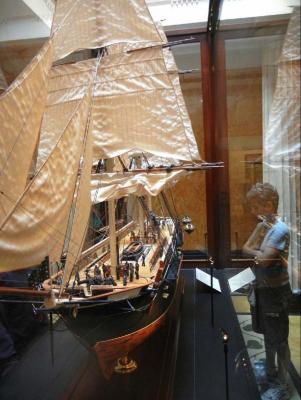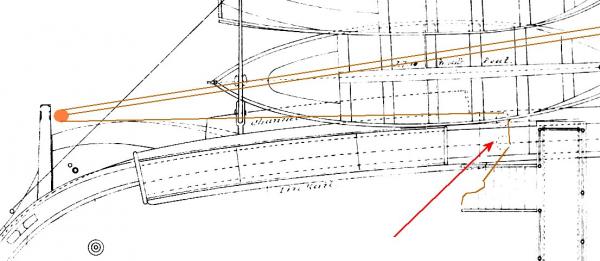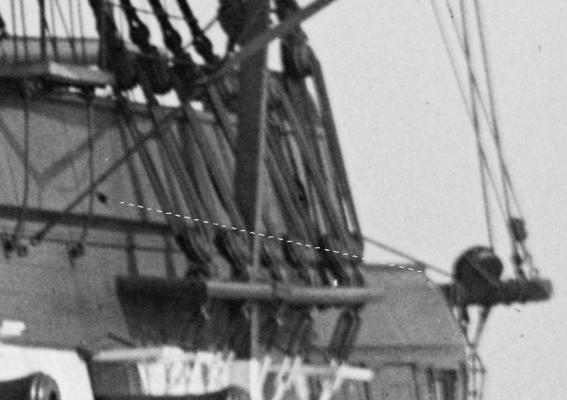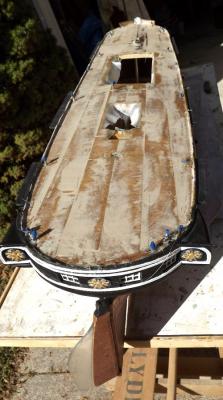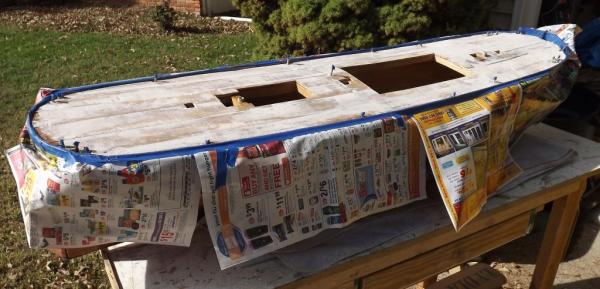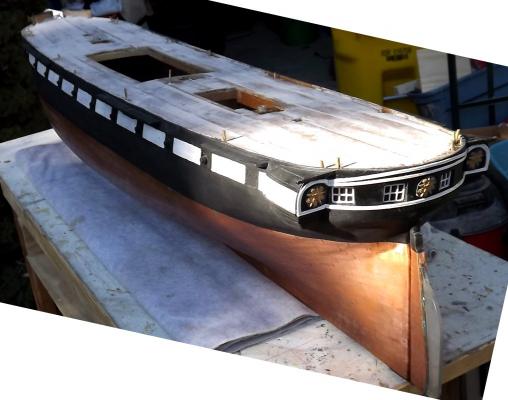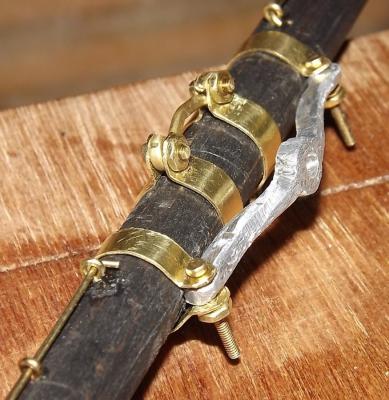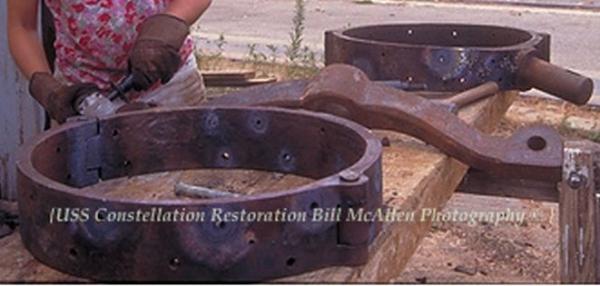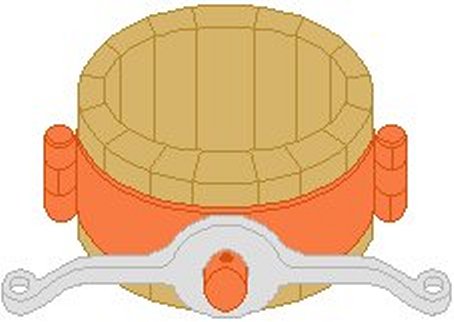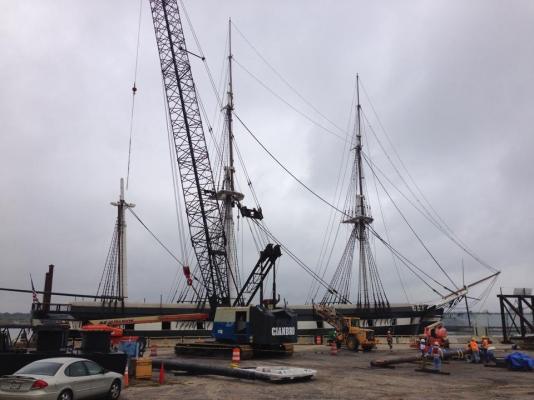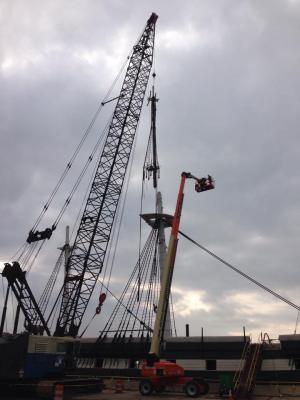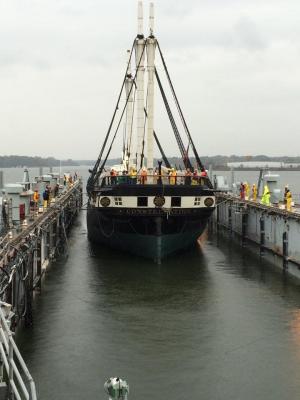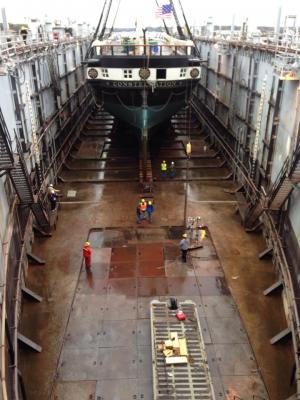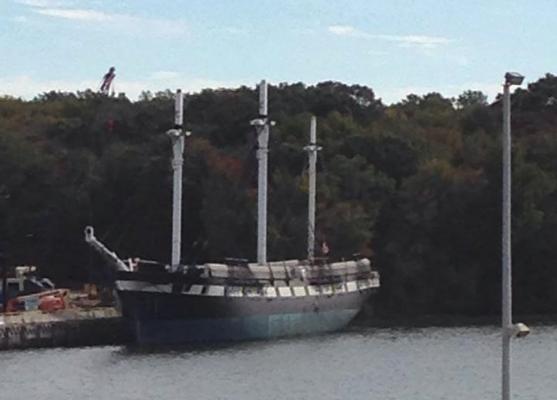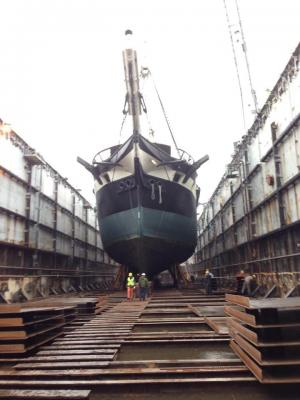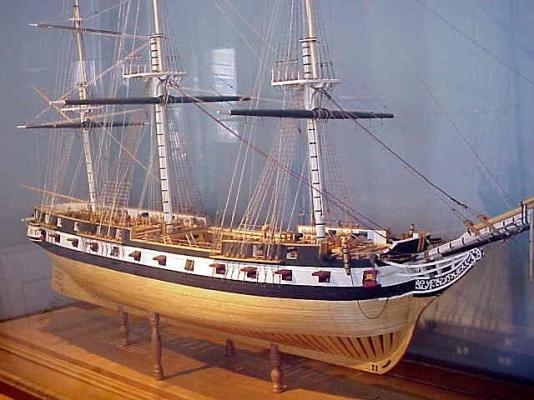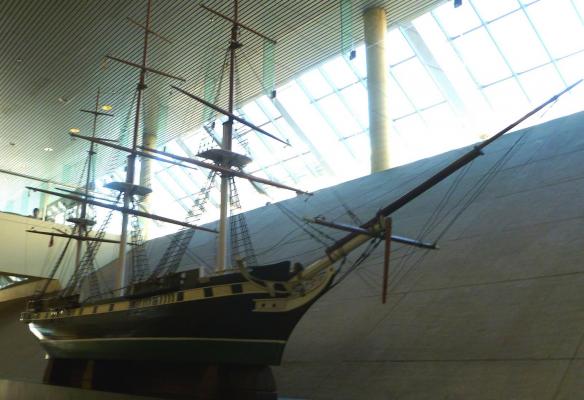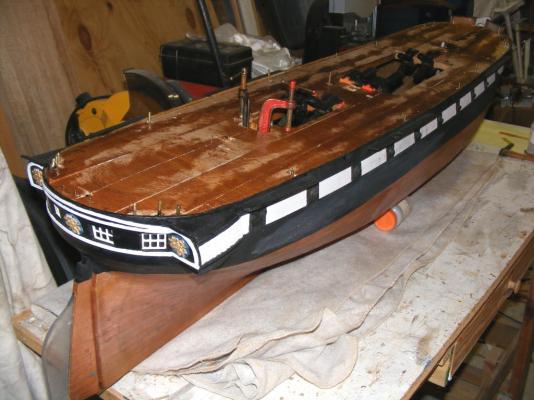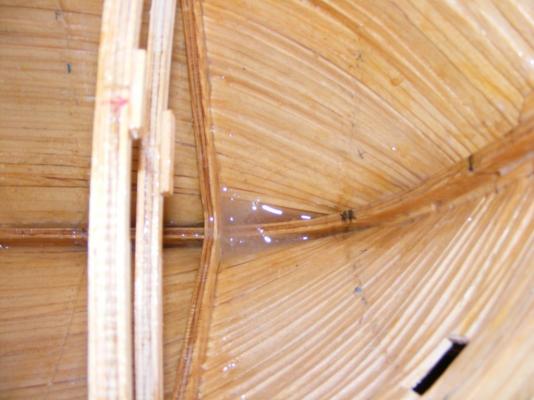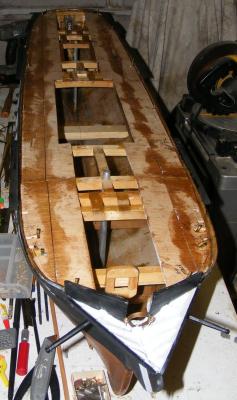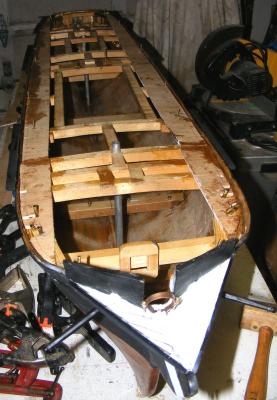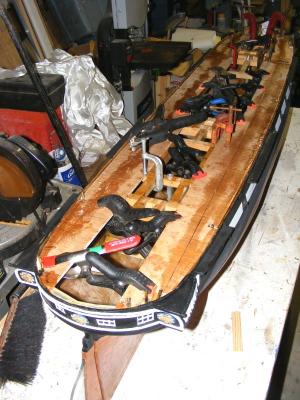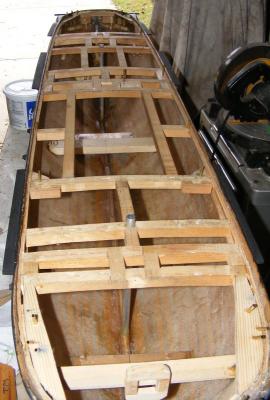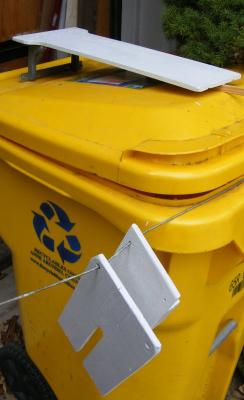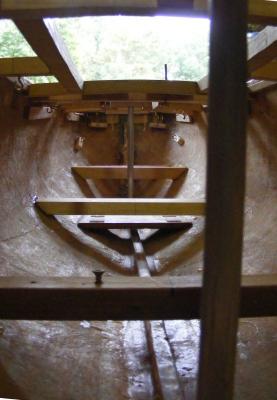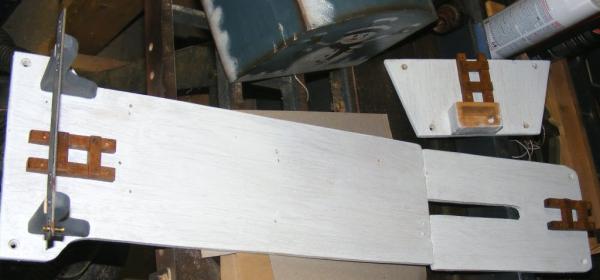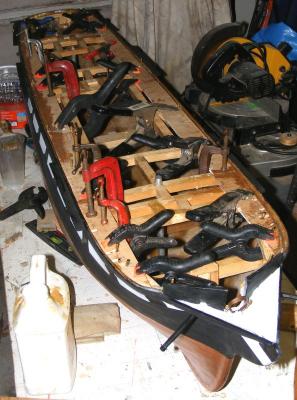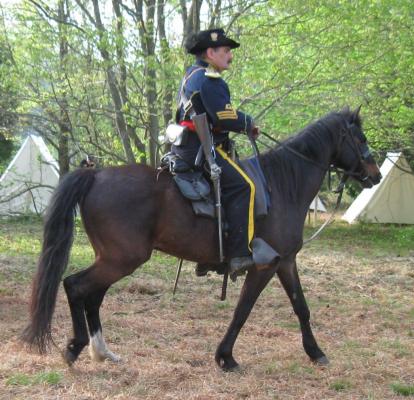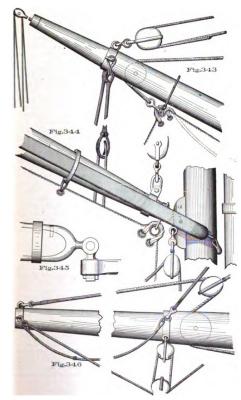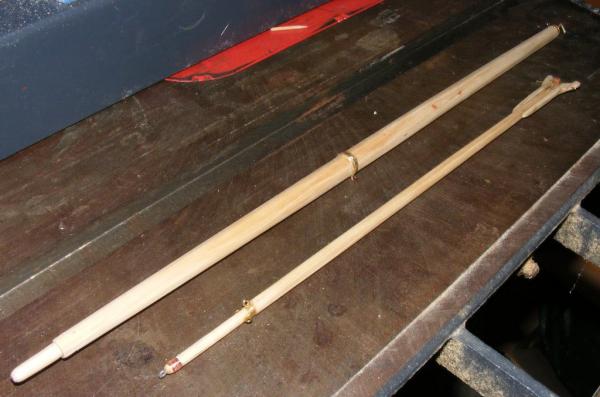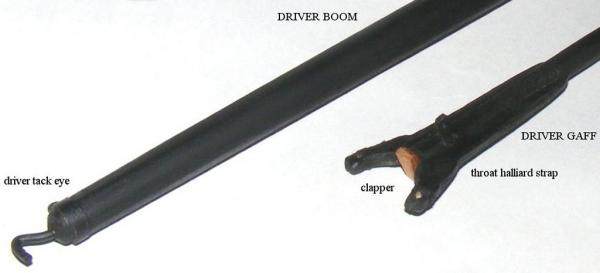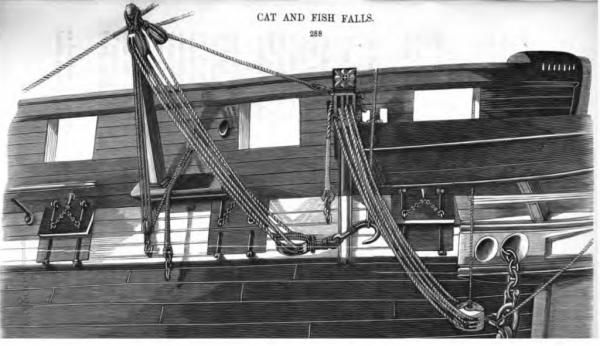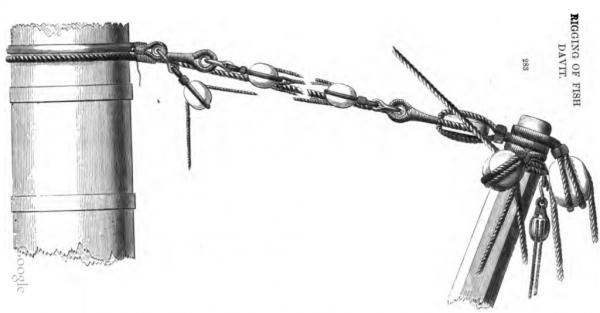-
Posts
875 -
Joined
-
Last visited
Content Type
Profiles
Forums
Gallery
Events
Everything posted by JerryTodd
-
I gave milling the maple for deck planking a shot. I determined I needed 3/16" x 3/16" x 6-5/8" pieces. I rigged the table saw and had no problem ripping out 3/16" little boards from the 3/4" thick piece, but ripping that into 3/16" strips wasn't working for me - I just couldn't get it rigged where it felt safe, so I broke down and ordered a pile of 3/16" x 3/16" x 48" basswood strips. The stock for the deck planking arrived Saturday, and Sunday I cut it into 6-5/8" lengths. That got 7 pieces from each 4 foot length leaving a piece about 1-1/2" long for the scrap box. In all there's 234 planks. After sawing all that lumber, Ivan was upset to learn he had 5 more to cut. He was even more upset to learn he had 266 more after that! Unfortunately, that's not enough. Have I mentioned math is not my strong suit? I was playing with the idea of 1/4" wide planks and may have confused my calculations with that, but... The deck is 61" long and 12-1/4" wide at it's widest point. The ends are nearly half round and there' maybe two plank widths on either side of "bulge," ie: the deck is nearly rectangular, with rounded corners. 61" requires 9.2 planks end-to-end and 12-1/4" requires 67 3/16" planks across - that's 616.4 planks to cover the deck. But wait! There's a 14-1/4" x 6" main hatch and a 6" x 3-1/4" battery hatch opening. They add up to 104 planks I don't need. I estimate the "corners and other small hatches and openings will negate some 12 planks, so that's 616-116=500. That means I need 266 more planks beyond what I have! Time to order another 37 4 foot pieces - actually I ordered 40. In the meantime, I figured out and opened the aft hatch. The deck portion that was cut out got a cambered frame epoxied to it's forward edge. The rest of it will get framed in a similar manner. The perimeter of the hatch opening will also be framed with a small ledge for the hatch to sit on. This ledge will have some weather-strip material to keep water out. I'd like to make some sort of dead-bolt locking mechanism that uses the pivot gun as it's lever to latch the hatch down - but that may be more trouble than it's worth. If so, I'll simply fasten this hatch down with countersunk screws. The gun will still serve as a handle to lift out the hatch cover/deck section.
- 553 replies
-
- sloop of war
- constellation
-
(and 3 more)
Tagged with:
-
This painting of Cumberland's fight with Virginia is at the Mariner's Museum in Newport News VA. It's an interesting painting with all sort's of things wrong with it - but it get's the feeling across. Of those many emails we get from hobby suppliers announcing sales and such came one announcing that naked man here was going on sale. The Brothers Nude will serve as the masters for my clone army, or rather navy of 1:35 scale clones - ie: crew. From another hobby supplier (RBModel in Poland) I got some brass stuff; belaying pins, working shackles, and a pair of clevis parts that made a perfect goose-neck for the driver boom, replacing the old hook. Sorry for the blurry shot, I'm using a new used camera and I haven't got it completely figured out yet. I used some of the thin strip wood from some old wood kits to make a set of sail hoops for the driver. Just slice the strip to width, wet, and wrap around an appropriate size dowell. Glue them up when they're dried.
- 553 replies
-
- sloop of war
- constellation
-
(and 3 more)
Tagged with:
-
A launch with an awning - that looks like a sail
- 420 replies
-
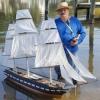
Let's talk 3D printers.
JerryTodd replied to Keith_W's topic in Modeling tools and Workshop Equipment
I had masters (from which I will cast the battery in resin) for my Macedonian's guns 3D printed; 5 32 pdr carronades and 5 18 pdr Bloomfield pattern guns is 1:36 scale - $250 That, BTW, was the "discounted price" because a friend was getting a bunch of other items printed as well. 5 of each was a minimum order A company that digitally scanned the Macedonian figurehead at the naval academy found me online and offered to 3D print one in 1:36 scale for me for a mere $250. I'm very happy with the quality of the guns but this isn't sustainable at all for someone like me. There's no way I'm going for that figure head, or anything else for that matter, and there's a lot of things I'd love work up in CAD and just print - those god-forsaken trailboards on Constellation, for instance. At $5 a gun, I would have had them print the entire battery, and come back for something else - as it is, they aren't going to see me again. -
Yes, that's a quarter gallery. Constellation appears to have all the windows, but they're painted over with only the one sash left open, while Cumberland and Savannah seem to have planked up galleries with only a small port left open. I was going to say the number of gun ports was wrong for Cumberland by just looking at the plans for her and her sisters (Brandywine) as frigates but Chapelle shows her as a razee with 13 ports, not counting the one covered by the quarter gallery. So they reduce the number of gun ports when they razeed them? How was the image IDed as Cumberland, d'ye know? The attached painting shows up IDed as the Levant. It's not Levant by any measure, and I'm certain it's Constellation because it's not Macedonian or any of the razeed Brandywines (RB's), and the other sloops had fewer gun ports. A profile comparison of Constellation and Levant to scale. Savannah an RB shows 14 ports contrary to what the Portsmouth image and Chapelle show for Cumberland. Every time I look, I find something I overlooked before - I never noticed the change in the number of gunports on the Brandywines and Macedonian when they were razeed. And the different number on the different Brandywines - Cumberland 13, Savannah - 14. Look at all the great details in this photo of Macedonian in the 1860s: She sports a bridge deck, the catting boom's replaced the catting davit, she has drop bulwarks like Constellation's up forward.
- 553 replies
-
- sloop of war
- constellation
-
(and 3 more)
Tagged with:
-
Someone here went to the museum in Savannah where the model is displayed, and posted images of it before the MSW crash. I saved them because of her similarities to Constellation in some respects, As this most recent case, she's been very influential in my building Constellation. I think she's 1:24 scale. I found out who built her and tried to find a contact for him a while back - with no luck. I'd love to talk to him about the ships and research sources because I found he came to the same conclusion on some things, and may have some information I missed, like this recent revelation. I hope to see the model in person someday, and take my own photos of key items of interest to me - Constellation will probably be long complete by the time that happens.
- 553 replies
-
- sloop of war
- constellation
-
(and 3 more)
Tagged with:
-
Looking at how decks were done on other models, especially larger models like mine, I came across this image that was posted on MSW a long time ago, of the Savannah. What caught my eye wasn't the deck, but where is the main brace going? The 1888 spar deck drawing (the archives lost the 1854 drawing) shows a chock through the bulwark just forward of the mizzen channel. I never figured out what this was for, except maybe something to do with the main stuns'l boom. Any photo where I can see the main brace lead, it goes through the bulwark right there at the boomkin. The Savannah model made me realize something - ALL those photos of Constellation are after the aft folding bulwarks were replaced by a solid bulwark. But when the folding bulwarks were in place, running the main brace there would be in the way. So, here's a portion of a 1914 image where you can see the chock through the bulwark with nothing rove through it, and the main brace block on the boomkin. I added a dashed line to show the old lead. Changing the main brace fairleads on the model won't be a big deal, I can reach inside where the new fairlead will go, and it actually clears up some traffic issues I had back at the quarters, but... Where did the main sheet go?
- 553 replies
-
- sloop of war
- constellation
-
(and 3 more)
Tagged with:
-
So, I haven't had the chance yet to set up the saw for milling the deck planking, but I have been researching the subject. The oldest image I've found that shows the deck shows the ship had planks that were about 8 inches wide (relative to people's feet). At some point by 1914 she was redecked with narrower planks, around 4 inches wide. The restoration's no help - they've done something completely different. What I was trying to determine was if the planks were nibbed into a margin plank fore and aft. I can't find anything that shows that. I haven't just been looking only at Constellation but also at photos of her contemporaries, mostly via Civil war images. Of those, where it can be seen, I can't make out evidence of a margin plank with plank ends nibbed in. Meanwhile, I hemmed some of the sails; all the t'gallants and royals. The main coarse was hemmed just today. I was just asked how I intend to reduce sail if needed. All the sails will have operable buntlines, clewlines, etc (manual, not RC) The t'gallants and royals will also be fairly easy to remove, yard and all. With the coarses bunted up and the t'gallants and royals off her - she'll be ok in most conditions, If not, I won't be sailing her.
- 553 replies
-
- sloop of war
- constellation
-
(and 3 more)
Tagged with:
-
As promised, the weather was beautiful today, and I took advantage of it to fiber-glass the deck. I masked the hull from the probable drips, mixed up the last of the epoxy Mark gave me, painted the sub-deck with it, laid the glass cloth on it, and wetted it down. I used every drop of the epoxy and it set up perfectly. I went and got something to eat and drink, and when I got back I was able to trim the mast openings and hatches. I need to get more epoxy to glue down the deck planking, but first I have to mill up the maple board into planks.
- 553 replies
-
- sloop of war
- constellation
-
(and 3 more)
Tagged with:
-
Meanwhile, back on the smaller version.... Making the trusses for the tops'l yards isn't going as well as the coarse yard trusses did. The first failed, I nicked into it while cutting nearly cutting it in half, and making it unusable at any rate. The second needs a lot of finishing, to be usable, even then there's two more to make and then the parrels. I haven't figured out how I'm going to make the hinged band that's the parrel. These are lined with wood staves, almost like a barrel I rooted around till I finally found the Bondo, and went at the deck with it. The stuff was setting up so fast I could hardly mix more than a putty knife full without it going off before I could use half of it. I got most of it done, but there's more to do, specifically around the deck-hull joint. It's supposed to get almost to 80° around here tomorrow, so I'm hoping to finish the Bondo job and get the glass laid. While that sits in the sun, I'll start milling up the deck planking from some maple I found while looking for the Bondo. I'm sure pine would have done fine for the deck, but the harder maple will be less prone to dings and dents as I work on the model after the deck is on.
- 553 replies
-
- sloop of war
- constellation
-
(and 3 more)
Tagged with:
-
Today, in 1812, Macedonian met the American frigate United States near Madeira in an action lasting just over an hour. After overwhelming fire from the more heavily armed United States, Macedonian struck. After two weeks of repairs at sea to preserve the ship, she was taken into American service where she served until she was decommissioned in 1828 and broken up. The opening of the battle by Gardner. See here for =>More Details about Macedonian
- 97 replies
-
- macedonian
- frigate
-
(and 2 more)
Tagged with:
-
The real ship was towed over to Curtis Bay Coast Guard Yard near Baltimore during the week. She joined the training bark Eagle already there and out of the water. Her rig was reduced and she was loaded into the floating dry-dock, formally Navy ARD-55 (I think). I don't know specifically what work is to be done, though she suffers from the usual problems a wooden ship that sits at a dock suffers from. Thanks to Chris Rowsom, Director of Historic Ships Baltimore for the images. If you're ever in town, do visit Constellation, there's an interesting pair of models, both 1:48 scale, in her visitor's center: A model of the ship as she appeared in the 20th century into the 1940's. Builder unknown. The McArdle model of the ship as she was originally being restored. Another model of the ship is located at the Baltimore Convention Center. It's a waterline model of the sloop "restored" as a frigate again, in 1:24 scale I think, but this one was built to go on display at the 1964-65 World's Fair in New York. I remember this model when I went to the fair, always love model boats
- 553 replies
-
- sloop of war
- constellation
-
(and 3 more)
Tagged with:
-
This year? Probably not, but her deck will be laid, coamings installed, hatches. Maybe even bulwarks, and her deck furniture done, so she'll definitely look a lot more like finished than she does.
- 553 replies
-
- sloop of war
- constellation
-
(and 3 more)
Tagged with:
-
And the final sub-deck sections are epoxied down. Besides the clamps you see I used some 5/8" common wire nails to tack everything down. The excess epoxy got poured into some of the nooks and crannies in Macedonian's hull. I like to fill these tight spaces so water can't get in there and get mold growing. You know, Mac hasn't gotten wet yet, hmmm. Nah, I want to get moldings on her so I can paint her. Anyway, the tops'ls were unbent from their yards and the yards are ready to receive their hardware. I'll let the deck sit for a while, then I need to clean off the blush from the epoxy. This is stuff from the hardener that rises and leaves a sticky film on the surface. It's washed off with soap and water - which should prove interesting. After that, the sub-deck will get sanded, filled, and sanded some more. Then it gets a layer of cloth on it, which will involve cleaning more blush and sanding. That should stiffen the deck enough for me to cut the fore and aft hatches out - which will get framed - till then, I can't put the rudder tiller and controls back in. There's a lumber yard near by that may have some decent wood for me to mill my deck planking from; yellow pine would be nice. I also need to find something to tint my epoxy to the reddish brown of rosin based pitch as was used in Constellation's time.
- 553 replies
-
- sloop of war
- constellation
-
(and 3 more)
Tagged with:
-
Clamps off, the next two sections will go on one at a time so I can clamp one, and figure out how I'll hold down the last one. I think it's time to break out the compressor and brad nailer. In the meantime, Hardware got attached to the upper yards. The main t'gallant's just painted and the royals need a bit more hardware yet. The holes in the t'gallants are for the royal's sheets - I didn't put sheet holes in the royal yards as I can find no evidence Constellation ever set skys'ls - this one certainly isn't. The main t'gallant here has a post for it's stuns'l boom iron, but I'm going to go about those another way which will involve some soldering. The royals all done. Note the eyes for the brace blocks are on the forward face of the mizzen t'gallant and royal yards as they brace forward to the main mast - I actually got that right on the first try without having to redo anything. sometimes I amaze myself. The yards, boom, gaff, and wisker booms all painted. The yards still need jackstays installed to be complete. The stuns'l booms and trys'l gaffs are yet to be made, but the corse and tops'l yards need their hardware first.
- 553 replies
-
- sloop of war
- constellation
-
(and 3 more)
Tagged with:
-
When you need to use them, you cut the lashings, or unshakle them, as the case may be. There's a section on such things in Steel (hsna.org & books.google.com)
-
- 553 replies
-
- sloop of war
- constellation
-
(and 3 more)
Tagged with:
-
Bob, after seeing your brass work on the Howard, that's very high praise, maybe too high? In preparation for putting down the sub-deck I pulled out the equipment decks so any epoxy dripping wouldn't get on them or the running gear.. I gave the hull a good going over inside with a vacuum and a stiff brush. I removed the mast steps, cleaned and sanded the deck sections and painted them white, then reattached the mast steps while the paint was still tacky. One of the equipment deck beams came loose. Oddly, the epoxy didn't seem to be completely set - it was rubbery and oily feeling. It's been in there since 2009! I sanded and cleaned the spots in the hull with acetone and made a new beam that fit better and epoxied it in. Today I actually epoxied the first two outboard-most strips of the subdeck to the hull. While I had the epoxy mixed I sloshed it on the chainplate backer blocks, the rudder cable guide blocks, the joints where the equipment deck beams attach to the hull, and the underside of the subdeck sections were completely painted in epoxy, as well as the tops and side of the spar-deck beams and the deck clamp. I still had a little left over, which I gave Macedonian's wales a coat, and the seams of her frames got a slosh as a couple of spots popped loose with all the handling she's gotten lately. This is a mile stone that will allow me to move on with the hull, but I keep getting that feeling of locking the door and realizing the keys are inside. This epoxy was left over from when my friend Mark built his skiff and it seems to set fairly slowly. I was slapping in on things for a good half hour and it never got warm or started to gel. I went out for the night and when I got back It was already set up enough to take off the clamps, but I'll leave them on till tomorrow when I set down the next two sections. While that sets, I'll unbend the sails and start working on adding hardware and details to the yards - more brass Bob! I have a zillion little eyes to set in the yards for the jackstays.
- 553 replies
-
- sloop of war
- constellation
-
(and 3 more)
Tagged with:
-
Coppering only turns green OUT of the water, and most privateers probably weren't coppered - coppering's expensive and these boats were the Saturday Night Specials of the sea. (see page 208 of The Search for Speed Under Sail) Both Pride's and several other recreations/replicas use that bird-poop colored green bottom paint I guess cause it looks like copper gone green and dull copper/brown bottom paint must not be available. But it's more likely a privateer's bottom would be painted in the lime and tallow, or white bottom Chapelle points out.
-
What size/scale are you looking for? There's a variety of braided line available in lots of colors, even camo, at hardware stores and such - parachute or para cord. I'm not sure how small that gets. I think there's some modern model yacht companies that sell smaller stuff. A quick search of "braided model yacht line" got me: http://www.cornwallmodelboats.co.uk/acatalog/cap-Dacron-Braided-Thread.html You use a few colored threads and do a round sennit to make stuff that's very small. http://www.wikihow.com/Make-a-4-or-8-Part-Round-Braid
-
I was in the mood to do some planing over the weekend, and made the gaff and boom for the driver/spanker. These were made from some nice clear pine left over from a sea chest I made for someone. The hardware and other details were based on the usual examination of every image I can find, and the Text-Book of Seamanship by Luce. The blocks and guides for the steering cable were permanently epoxied in place, as were some oak blocks forward to give the chain-plate fasteners something to grip down-the-road. All this wood will get a coat of epoxy when I start laying the sub-deck, which, if the weather holds, should start this week, provided I don't wind up doing something for some one else.
- 553 replies
-
- sloop of war
- constellation
-
(and 3 more)
Tagged with:
-

Pennsylvania by threebs - 1/72 scale
JerryTodd replied to threebs's topic in - Build logs for subjects built 1801 - 1850
I did find some more fish davit references, not that it matters anymore They are from Nares Seamanship 1868 It would make for an interesting vignette
About us
Modelshipworld - Advancing Ship Modeling through Research
SSL Secured
Your security is important for us so this Website is SSL-Secured
NRG Mailing Address
Nautical Research Guild
237 South Lincoln Street
Westmont IL, 60559-1917
Model Ship World ® and the MSW logo are Registered Trademarks, and belong to the Nautical Research Guild (United States Patent and Trademark Office: No. 6,929,264 & No. 6,929,274, registered Dec. 20, 2022)
Helpful Links
About the NRG
If you enjoy building ship models that are historically accurate as well as beautiful, then The Nautical Research Guild (NRG) is just right for you.
The Guild is a non-profit educational organization whose mission is to “Advance Ship Modeling Through Research”. We provide support to our members in their efforts to raise the quality of their model ships.
The Nautical Research Guild has published our world-renowned quarterly magazine, The Nautical Research Journal, since 1955. The pages of the Journal are full of articles by accomplished ship modelers who show you how they create those exquisite details on their models, and by maritime historians who show you the correct details to build. The Journal is available in both print and digital editions. Go to the NRG web site (www.thenrg.org) to download a complimentary digital copy of the Journal. The NRG also publishes plan sets, books and compilations of back issues of the Journal and the former Ships in Scale and Model Ship Builder magazines.



